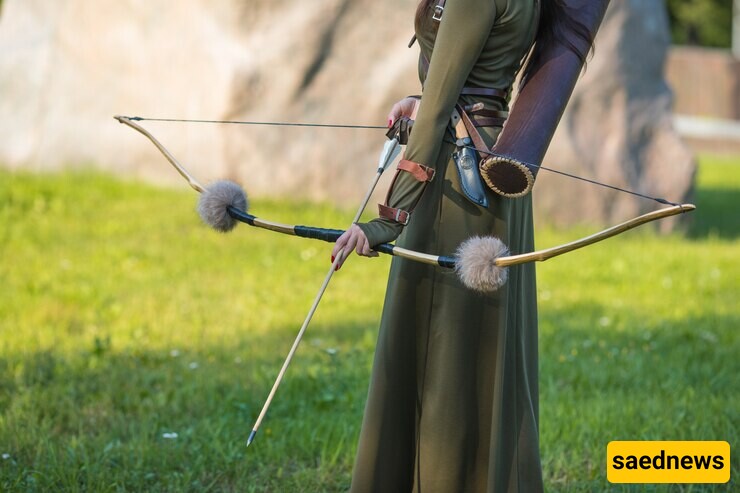SAEDNEWS: The crossbow, which you may know by other names such as zubin, zanbourak, horizontal bow, or rifle bow, is a tool used today primarily for sport but was historically one of the primary weapons of war.


The crossbow, or steel bow, known in Iran as zubin or rifle bow, is a combination of a bow and a gun. It is widely used for hunting due to its high power and low noise. Its design features a bow mounted on a wooden or occasionally metal stock. The crossbow differs significantly from compound and recurve bows in its functionality and method of shooting.
The crossbow was invented by Europeans during the Middle Ages and later adopted by the Ottomans and other Islamic countries. This military weapon was highly destructive and powerful, making it widespread in Europe. Its primary use was targeting knights, as their metallic armor was impenetrable by swords and wooden arrows. Due to the high velocity and metal bolts of the crossbow, it could pierce through such armor effectively.
Europeans used the crossbow to bring an end to the reign of knights in the Middle Ages. Crossbows at that time were simple in design, with basic functionality that made them easy to use, requiring no significant skill or practice. The design featured two separate or integrated arms mounted on an oak stock, with a basic trigger mechanism for simplicity.
After the invention of early firearms, such as muzzleloaders, the use of crossbows declined significantly. However, in recent decades, crossbows have re-emerged with modern designs and enhanced features. Today, they are no longer used for warfare but are popular for recreational activities and hunting.
Draw weight refers to the force required to pull the crossbow string back to 71 cm (28 inches). Hunting crossbows typically have a draw weight between 150 to 350 pounds and shoot bolts at speeds ranging from 80 to 120 meters per second. The effective range of a bolt after release is approximately 100 meters, but it can remain lethal up to 400 meters despite losing speed.
One-Handed Crossbows
These are less common and mainly used for target practice. They are lighter and more affordable than two-handed crossbows and are suitable for small game hunting or beginners, including children.
Two-Handed Crossbows
These are more versatile and widely used. They are suitable for hunting, target shooting, fishing, and even military purposes.

Easy to use without prior archery training—users only need to learn stringing techniques.
Silent operation.
Resembling firearms, they are easy to handle.
High power, making them ideal for hunting, as their small bolts can penetrate through game animals.
Archery offers more enjoyment compared to crossbows, which resemble firearms in their mechanics and experience.
Heavier than traditional bows, weighing around 4-5 kg, nearly double that of compound or recurve bows.
Lower speed and power compared to compound bows, which typically have longer draw lengths and higher velocity.
For instance, the speed of a 70-pound compound bow often exceeds that of a 150-pound crossbow. Additionally, compound bows allow more precise aiming over various distances using sights and pin sights.
The best crossbow varies depending on individual needs and purposes. To choose the right crossbow, consider factors like speed, precision, functionality, ease of use, reliability, cost, and maintenance. The following brands are considered top choices in the crossbow market:
PSE Archery
Barnett
Mission
TenPoint
Important Note: Never shoot a crossbow without a bolt or with lightweight bolts, as this can cause the limbs to break.
Modern crossbows are available in two types: compound and recurve. Compound crossbows offer higher power and range, making them more suitable for hunting. Their reduced noise during bolt release makes them a better option than air rifles for forest hunting.
A 60-pound compound bow with a 76 cm (30 inches) draw length can shoot bolts at an initial speed of 106 meters per second (350 feet per second).
A 200-pound crossbow with a 50.8 cm (20 inches) draw length can achieve the same speed of 106 meters per second due to its higher draw weight compensating for the shorter pull.
Hunting crossbows generally have a draw weight between 150 and 350 pounds, with bolt speeds ranging from 80 to 120 meters per second. Their effective range is approximately 100 meters, but they remain lethal up to 400 meters upon impact.
Bolts for crossbows come in aluminum, carbon-aluminum, wooden, and fiberglass varieties. Bolt tips are available in three types: adjustable blades, fixed blades, and mechanical blades, all designed to penetrate game animals effectively.
As detailed, the crossbow is a unique type of bow that has been in use for centuries. Shaped like a gun, its handling and usage are similar to firearms. Crossbows are available in recurve and compound types, with beginners finding recurve models easier to use, while professionals favor compound models for their superior speed, power, and accuracy. With sights and pin sights, compound crossbows can achieve exceptional precision.

